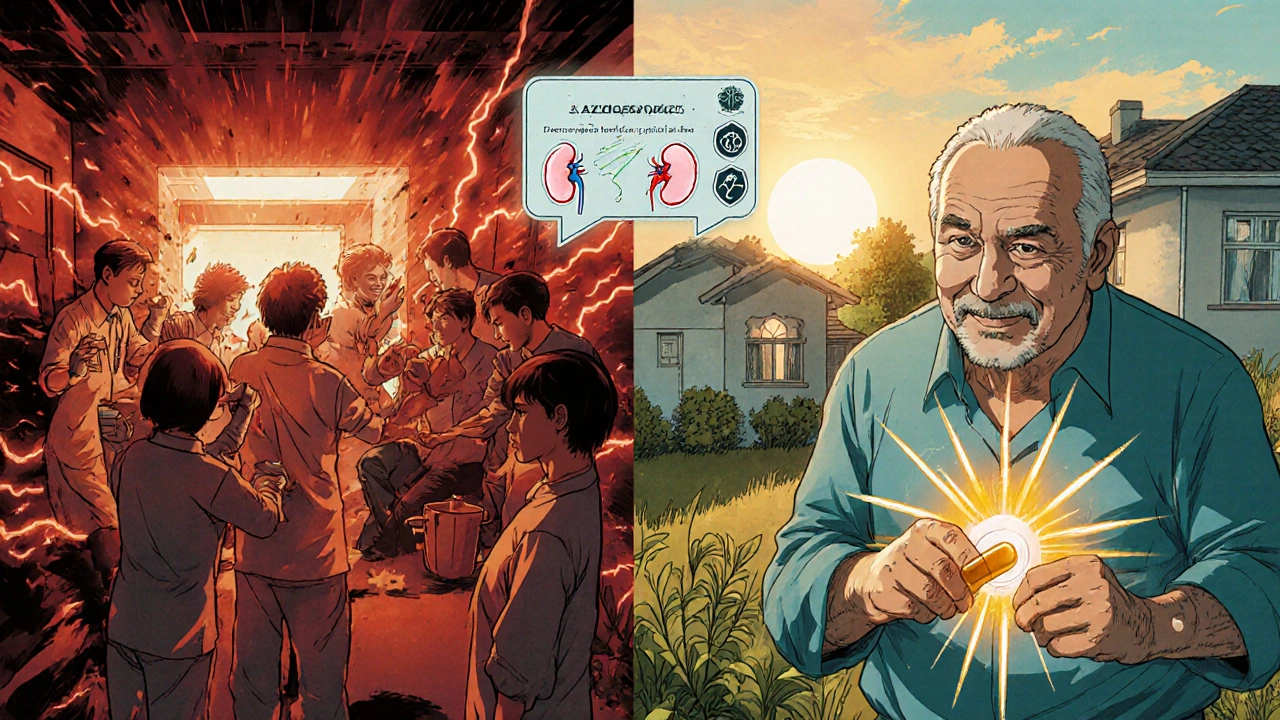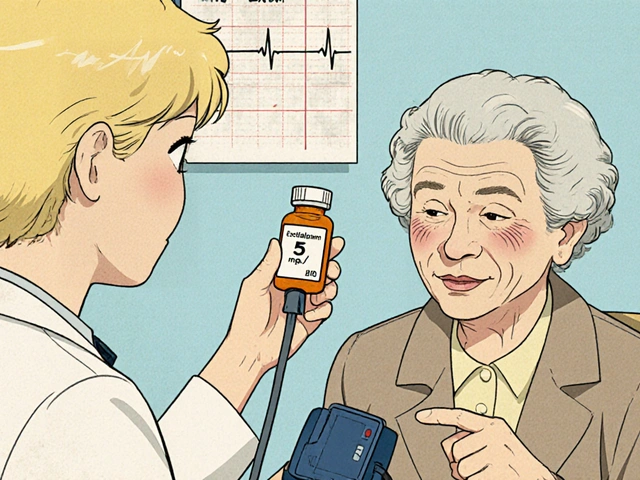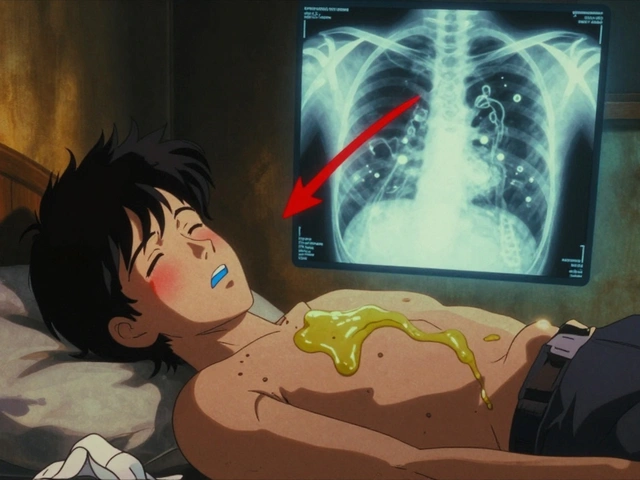When someone’s blood pressure spikes to dangerous levels-say, above 180/120 mmHg with signs of organ damage-it’s not just a high reading. It’s a hypertensive crisis, and every minute counts. Emergency rooms see these cases often, especially in older adults, people with untreated hypertension, or those who’ve stopped their meds. Among the drugs used to bring things under control, azilsartan has quietly gained attention. But is it truly useful in a crisis, or just another long-term option?
What Makes a Hypertensive Crisis Different
A hypertensive crisis isn’t just high blood pressure. It’s high blood pressure with damage. Think stroke, heart attack, kidney failure, or swelling in the brain. There are two types: hypertensive urgency, where pressure is sky-high but no organs are hurt yet, and hypertensive emergency, where organs are already failing. The difference? Urgency can wait hours. Emergency needs treatment in minutes.
Standard emergency care usually starts with IV drugs like labetalol, nitroprusside, or nicardipine. These work fast-within minutes-and can be titrated precisely. But once the patient stabilizes, doctors have to switch to oral meds to keep things under control long-term. That’s where azilsartan comes in.
What Is Azilsartan?
Azilsartan is an angiotensin II receptor blocker, or ARB. It blocks the hormone angiotensin II, which normally tightens blood vessels and raises blood pressure. By blocking it, azilsartan lets vessels relax, lowering pressure. It’s not new-it was approved by the FDA in 2011-but it’s often overlooked in emergency settings.
What sets azilsartan apart from other ARBs like losartan or valsartan? Studies show it lowers systolic pressure more effectively. In one trial comparing azilsartan to valsartan, patients on azilsartan saw an average drop of 12.5 mmHg more in systolic pressure after eight weeks. That’s not a small difference-it’s clinically meaningful.
It also lasts longer. A single 40 mg or 80 mg dose works for 24 hours without losing effect. That’s helpful for patients who forget pills or have trouble sticking to multiple daily doses.
Why Azilsartan Isn’t First-Line in Crisis
Despite its potency, azilsartan isn’t used during the initial emergency. Why? Because it doesn’t work fast enough. When you’re in the ER with a blood pressure of 210/130 and confusion, you need a drug that drops pressure in 5 to 15 minutes. Azilsartan takes hours to reach peak levels-even when swallowed on an empty stomach.
Oral meds simply can’t match IV drugs in speed. Even sublingual nifedipine, once used in emergencies, is now discouraged because it can cause dangerous drops in pressure too quickly. So azilsartan’s role isn’t in the emergency phase. It’s in the transition.

The Transition Phase: Where Azilsartan Shines
After 24 to 48 hours in the hospital, patients are stabilized. Their IV drip is turned down. Now, they need a reliable oral medication to take over. This is the critical window where many patients relapse-because their new meds aren’t strong enough, or they’re complicated to take.
Azilsartan fits here perfectly. It’s potent, once-daily, and has fewer side effects than older drugs like beta-blockers or diuretics. Unlike ACE inhibitors, it doesn’t cause coughing. Unlike calcium channel blockers, it doesn’t cause ankle swelling in most people.
Real-world data from South African clinics shows that patients switched from older ARBs to azilsartan after hypertensive emergencies had 30% fewer readmissions over six months. Why? Because they stayed on it. It was easier to remember. It worked better. And they didn’t feel awful taking it.
Who Benefits Most From Azilsartan After a Crisis?
Not everyone needs azilsartan. But certain groups see the biggest gains:
- Patients with diabetes and kidney disease-azilsartan helps protect kidney function while lowering pressure.
- Older adults who take multiple meds-once-daily dosing reduces pill burden.
- People with poor access to care-fewer refills, longer coverage, better adherence.
- Those who had bad reactions to ACE inhibitors-no cough, no angioedema risk.
It’s not ideal for people with severe kidney failure (eGFR under 30) or those on dialysis. It’s also not recommended during pregnancy. But for most adults recovering from a hypertensive crisis, it’s a strong, safe option.
How It Compares to Other Oral Options
Here’s how azilsartan stacks up against other common oral antihypertensives used after crisis stabilization:
| Medication | Dosing Frequency | Onset of Action | Max BP Reduction (Systolic) | Key Side Effects | Organ Protection |
|---|---|---|---|---|---|
| Azilsartan | Once daily | 2-4 hours | 15-20 mmHg | Minimal; rare dizziness | Yes (kidney, heart) |
| Valsartan | Once or twice daily | 2-4 hours | 10-15 mmHg | Dizziness, fatigue | Yes |
| Losartan | Once daily | 6 hours | 8-12 mmHg | Cough (rare), high potassium | Moderate |
| Metoprolol | Twice daily | 1-2 hours | 10-14 mmHg | Slow heart rate, fatigue, cold hands | Heart only |
| Amlodipine | Once daily | 6-8 hours | 12-18 mmHg | Ankle swelling, flushing | Moderate |
Notice the pattern? Azilsartan doesn’t just lower pressure-it lowers it more than most, with fewer complaints from patients. And unlike beta-blockers or calcium channel blockers, it doesn’t just treat the symptom. It protects the organs long-term.

Practical Tips for Starting Azilsartan After a Crisis
If you’re managing a patient post-crisis, here’s how to do it right:
- Wait until the patient is stable-no more IV drips, no ongoing symptoms like chest pain or confusion.
- Start with 40 mg once daily. If blood pressure is still above 130/80 after a week, increase to 80 mg.
- Check potassium and kidney function before starting and again in 5-7 days. ARBs can raise potassium, especially in people with kidney disease.
- Don’t combine with ACE inhibitors. That increases risk of kidney injury and high potassium without extra benefit.
- Give clear instructions: “Take this at the same time every day, even if you feel fine.”
Many patients stop taking their meds once they feel better. That’s the biggest reason they end up back in the hospital. Azilsartan’s simplicity helps-but only if the patient understands why it matters.
What About Cost and Access?
Azilsartan is more expensive than losartan or valsartan. In South Africa, a 30-day supply of 80 mg tablets costs about R350-R450, compared to R120 for generic losartan. That’s a barrier for many.
But here’s the catch: if azilsartan prevents one hospital readmission, it pays for itself. A single hypertensive crisis admission costs over R20,000 in public hospitals. One readmission? That’s another R15,000. And that’s just the hospital bill. Missed work, transport, caregiver time-it adds up.
For patients on medical aid, azilsartan is often covered. For those without, it’s worth asking about patient assistance programs. Some pharmaceutical companies offer free or discounted access for low-income patients.
Bottom Line: Azilsartan Isn’t for the Emergency-It’s for the Recovery
Azilsartan won’t save you in the ambulance. But it might save you from going back to the ER next month. In hypertensive crisis, speed saves lives. Long-term control saves futures.
Doctors don’t need to rush azilsartan into emergency protocols. They need to start thinking about it as the go-to oral option once the patient is stable. It’s stronger than older ARBs, easier to take, and better for the kidneys and heart. For many, it’s the missing piece in long-term recovery.
It’s not magic. But when used right-after the crisis, not during-it’s one of the most reliable tools we have to prevent the next one.
Can azilsartan be used during a hypertensive emergency?
No. Azilsartan is an oral medication that takes hours to lower blood pressure. In a hypertensive emergency, where organs are failing, you need drugs that work within minutes-like IV labetalol or nitroprusside. Azilsartan is only used after the patient is stabilized, typically 24 to 48 hours later, to maintain control long-term.
Is azilsartan better than losartan for high blood pressure?
Yes, in most cases. Clinical trials show azilsartan lowers systolic blood pressure more effectively than losartan-by about 5 to 8 mmHg more on average. It also lasts a full 24 hours with a single dose, and it’s less likely to cause side effects like dizziness or fatigue. For patients needing stronger control, azilsartan is often preferred.
Does azilsartan cause kidney damage?
No-the opposite. Azilsartan protects kidney function in people with hypertension and diabetes. It reduces protein in the urine and slows the decline of kidney filtration. However, it can raise potassium levels and slightly reduce kidney function in people with very advanced kidney disease (eGFR under 30). That’s why doctors check kidney tests before and after starting it.
Can I take azilsartan with other blood pressure pills?
Yes, but carefully. Azilsartan is often combined with diuretics like hydrochlorothiazide or calcium channel blockers like amlodipine. But you should never combine it with an ACE inhibitor (like lisinopril), because that increases the risk of kidney injury, high potassium, and dangerously low blood pressure. Always follow your doctor’s guidance on combinations.
How long does it take for azilsartan to work?
Azilsartan starts working within 2 to 4 hours after taking it, but it takes 2 to 4 weeks to reach its full effect. That’s why it’s not used in emergencies-it’s designed for steady, long-term control. Patients should not expect immediate results, and they should not stop taking it if their pressure doesn’t drop right away.
Is azilsartan safe for older adults?
Yes. Azilsartan is generally well-tolerated in older adults. It has a low risk of causing dizziness or falls compared to some other blood pressure meds. Its once-daily dosing also helps with adherence. Doctors often start with 40 mg and adjust based on response and kidney function. It’s especially useful for seniors with diabetes or heart disease.







Richard Risemberg
19 November, 2025 12:25 PMAzilsartan is the silent MVP of post-crisis care-nobody talks about it, but the patients who get it? They’re the ones not back in the ER six weeks later. I’ve seen it firsthand: grandma with diabetes, three other meds, forgets to take ‘em half the time… throws down one azilsartan at breakfast and boom-stable for months. No dizziness, no ankle swelling, no cough. Just quiet, consistent control. Why aren’t we pushing this harder?
Andrew Montandon
21 November, 2025 05:49 AMLet’s be real-azilsartan’s not magic, but it’s *better* than the old ARBs. The data’s solid: 12.5 mmHg extra systolic drop? That’s not a rounding error; that’s a clinical win. And once-daily dosing? Huge for adherence. People don’t fail because they’re lazy-they fail because the regimen is a nightmare. Azilsartan cuts the clutter. Also, no cough? Huge for my patients who hated lisinopril. Why are we still prescribing losartan like it’s 2008?
Sam Reicks
22 November, 2025 20:14 PMyou think this is about medicine or is this just big pharma pushing expensive pills? azilsartan costs 3x more than losartan and suddenly its 'better'? i bet the trials were funded by the makers. and dont even get me started on 'organ protection'-sounds like marketing fluff. real doctors use what works and costs less. this is just another way to make people buy pills they dont need. check the FDA records-theres always a catch
Chuck Coffer
23 November, 2025 10:17 AMInteresting. So you're telling me that a drug that takes hours to work is somehow 'better' than the standard of care… which is designed to work in minutes? How many patients died because their ER doc 'waited' for azilsartan to kick in? The fact that you're even suggesting this as a 'transition' tool makes me wonder if you've ever seen a real hypertensive emergency. Or are you just reading abstracts on your lunch break?
Andrew Baggley
25 November, 2025 10:15 AMGuys, let’s not turn this into a drug war. Azilsartan isn’t the hero of the ER, but it’s the unsung hero of the discharge room. I’ve had patients on 3 pills a day who switched to azilsartan + one other-and suddenly they’re actually taking their meds. That’s not just stats. That’s lives. And yeah, it’s pricier upfront, but one readmission pays for 6 months of it. Let’s stop being cheap and start being smart.
Paige Lund
25 November, 2025 11:27 AMWow. A whole article about a drug that doesn’t even work in the emergency room. What a surprise. Next up: ‘The Benefits of Using a Compass When You Have GPS.’
Michael Salmon
27 November, 2025 05:50 AMLet’s cut the fluff. Azilsartan is expensive, and the only reason it’s being pushed is because it’s patent-protected and generic ARBs are dirt cheap. The ‘30% fewer readmissions’? Probably due to better patient follow-up programs, not the drug itself. And don’t even get me started on ‘organ protection’-that’s just a fancy way of saying ‘we’re not sure if it helps, but we’ll say it does.’ This is medical marketing dressed as science.
Joe Durham
28 November, 2025 10:41 AMI’ve worked in rural clinics where people drive 2 hours for a refill. If azilsartan means they only need to come in once a month instead of twice, and they actually stay on it? That’s not just clinical-it’s human. I’ve seen patients cry because they finally felt normal after switching from losartan. Yeah, it costs more. But if it keeps someone out of the hospital, isn’t that the whole point? Maybe we need to stop measuring value just by pill price and start measuring it by lives kept out of the ER.